2.1 The History of Leadership Theories
 We can all recognize a good leader when we see one, but defining what qualities and practices a good leader has can be difficult. In fact, the one thing that researchers seem to agree on regarding leadership is that they don’t always agree.
We can all recognize a good leader when we see one, but defining what qualities and practices a good leader has can be difficult. In fact, the one thing that researchers seem to agree on regarding leadership is that they don’t always agree.
Are great leader defined by their accomplishments? Are leaders defined by the appraisal of their followers? Is nature or nurture the more important factor in determining leadership? Can leadership be learned, or is there a magical combination of trait, behavior and situation that allows leaders to rise to the occasion? Historically, in western civilization, we’ve struggled to answer these questions, and in the next few sections we’ll give you enough information that you can start contemplating these issues along with us.
Learning Outcomes
- Discuss our understanding of leadership from the historical perspective
- Describe the early trait approach
- Describe the behavioral approach
- Describe the contingency approach and its variations
The History of Leadership
A leader may be considered a leader because of a formal relationship, provided by the possession of managerial rank in an organization. Or a leader can be informal, someone who steps up and provides that guidance from within a group of people, not necessarily the person who has been given decision making authority. (As we’ll discuss later in this module, not every leader is a manager and not every manager is a leader.)
Those are some fairly basic concepts about leaders and leadership. How did we arrive at what we understand about leadership today? Historically speaking, it’s been quite a ride. Let’s take a trip way back and take a look at how far we’ve come. (Note: this text will focus on the history of European and North American history, since we’re addressing a largely US-based audience. There is of course, a much broader and diverse history of leaders across the world not mentioned here.)
Leadership—Historically Speaking
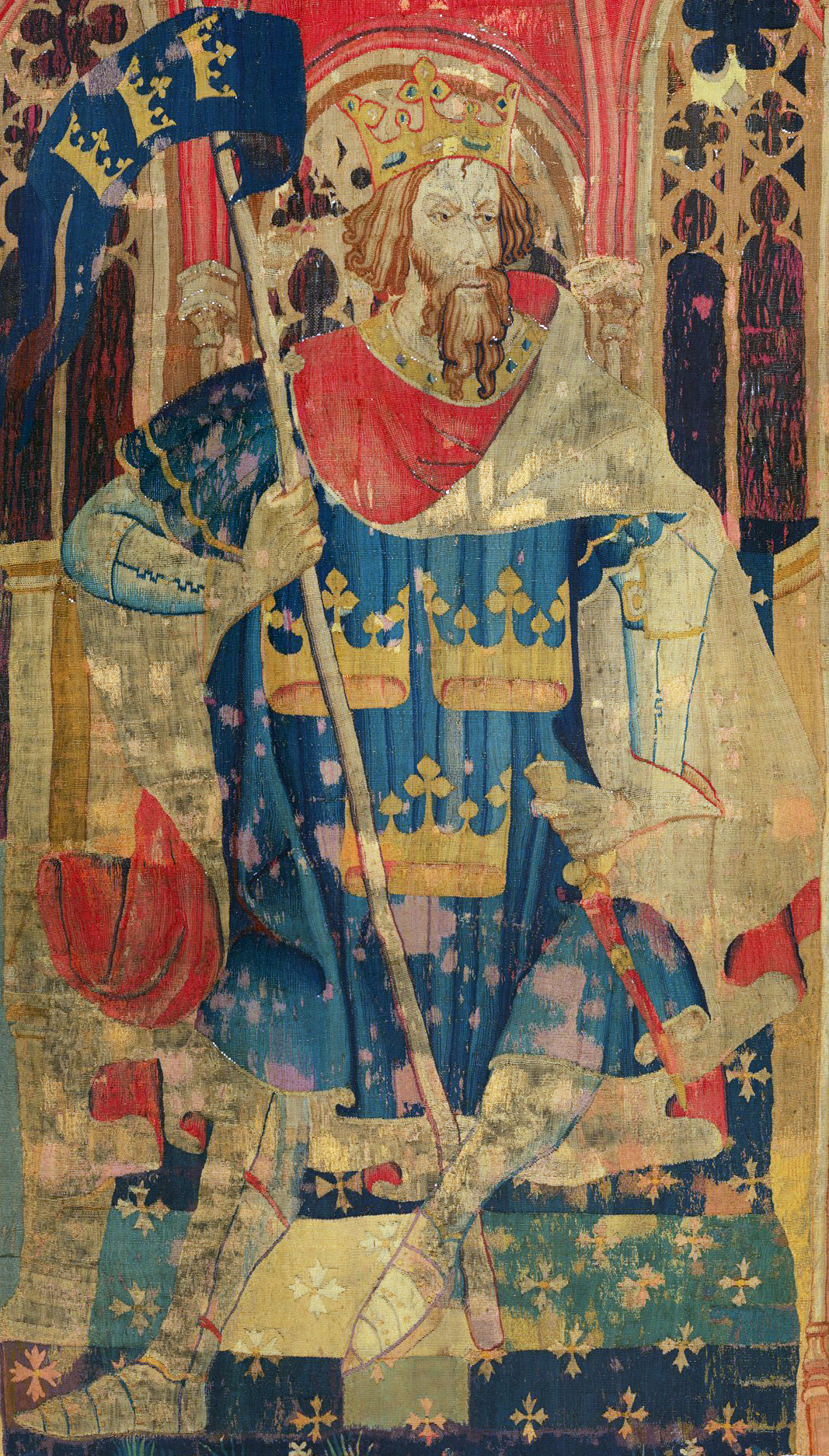 There are a few different varieties of King Arthur’s story, one of the most prominent folklore stories from England. Most versions tell either of how Arthur became king when the Lady of the Lake gave him a sword called Excalibur, or of how he was the only one capable of pulling the sword from a stone. Either way, he was the chosen one, he possessed a certain something, and, by divine right, he became the king of Britain.
There are a few different varieties of King Arthur’s story, one of the most prominent folklore stories from England. Most versions tell either of how Arthur became king when the Lady of the Lake gave him a sword called Excalibur, or of how he was the only one capable of pulling the sword from a stone. Either way, he was the chosen one, he possessed a certain something, and, by divine right, he became the king of Britain.
There’d be very few leaders among us today if we relied on a pulling-sword-from-stone selection process. Or, more likely, we’d watch the process unfold and then say, “Hey, nice trick, but why should I listen to you?” Concepts in leadership have changed since the sixth century.
Surely, anyone who knew the legend of King Arthur understood that it helped illustrate the concept that those who led were born and not made. Early concepts of monarchy included the element that king was a divine choice and was bound to no earthly rules. The right to rule was derived directly from the will of God. Those that were not kings were instead heroes, possessors of God-given skills that helped them achieve victory in battle. Some of these heroes were mythological, like Odysseus, descendant of the gods and hero of the Trojan War, and others, like Alexander the Great and Hannibal Barca, earned their distinction in battles won against nearly insurmountable odds, immortalized in stories retold over generations.
Plato, Plutarch, Lao-Tzu and even Machiavelli had an impact on how these rulers and heroes were defined in their instruction and shared opinions of what it meant to be a leader. Of course, they didn’t use the word “leader.” The word “leader” as we use it today didn’t come into the English language until the 19th century.
Still, thanks to them, the “leader as hero” concept had been a clear definition for hundreds of years. In 1840, Scottish writer Thomas Carlyle stated that “the history of the world is but the biography of great men.” The Great Man Theory took hold—the idea that history can be explained by the impact of great men and the decisions they made. These great men were identified by their charisma, intelligence, and wisdom. Carlyle suggested that these great men shaped history through these personal attributes and, yes, divine inspiration, too. (And since he lived in Scotland in the 1840s, there was no mention of women.)
In Carlyle’s book On Heroes, Hero-Worship and the Heroic in Society (Carlyle, 1840), the author dove into the lives of several men he deemed “heroes,” like Muhammed, Richard Wagner, Shakespeare, Martin Luther, and Napoleon. He believed that history “turned” on the decisions of these men, and encouraged others to study these heroes as a way of discovering one’s own true nature.
Studies were conducted on subjects who were already leaders, often members of aristocracy that had inherited their positions. Very few people with lower status had the opportunity to lead, and this contributed to the idea that these leadership qualities were something one was born with.
This Great Man approach was pretty fashionable in the 19th century, particularly with history professors who deferred to biographies of great men to teach their subject, rather than social histories. After all, it seems as if, when we faced some of our most difficult moments in history, a man emerged to lead us successfully through it. The existence of Abraham Lincoln, Theodore Roosevelt, and others like them only seemed to prove the theory.
The Great Man Theory was a predecessor of the Early Trait Theory stage of leadership research. In the United States, we were well into the experience of our industrial revolution, and it was clear that leaders weren’t just heroes and rulers. At the turn of the twentieth century, we were starting to understand the nuances of management and what it meant to be more strategic in leading. Could personality traits predict success in leadership?
Early Trait Approach
From the turn of the century until the 1940s, most leadership studies focused on the personality traits of individuals that made them leaders and not followers. Thomas Carlyle set the stage for the great man theory, and other researchers followed suit, trying to determine what kind of traits made a great leader great.
Francis Galton, an English scientist and researcher, wrote a book Hereditary Genius in 1869, which was the first social scientific attempt to study genius and greatness (Galton, 1869). To determine if human ability was hereditary, he chose “eminent” men (men who exhibited extraordinary leadership qualities) and counted the relatives to see how many additional “eminent” men were in their background. Galton hypothesized that there would be a higher percentage of “eminent” men in their lineage than in the general population. His testing (for which he invented methods of historiometry) showed that numbers of eminent relatives dropped off when going from first degree to second degree relatives, and from second to third. He took this as evidence of the inheritance of abilities.
As you might guess, even Galton recognized the limitations of these studies. He went on to study twins and adopted children, testing the “nature vs. nurture” term that he’d coined, but never strayed too far from the idea that qualities were inherited instead of taught.
In the early 1900s, American psychologist (and, like Galton, a eugenicist) Lewis Terman studied gifted children, and he conducted a variety of studies on the children and their parents to reinforce the idea of inheritance of abilities. And in the July, 1928 issue of The Journal of Abnormal and Social Psychology, researcher W.H. Cowley wrote,
The approach to the study of leadership usually has been and perhaps always must be through the study of traits. Leadership obviously is not a simple trait but rather a complex of main traits fashioned together as a unity. An adequate appraisal of leadership would reduce this complex to its individual units, and any study of leadership to be of value should produce a list of traits which go together to make the leader. (Cowley 1928)
In 1948, after years of experiments and studies, researcher Ralph Stogdill determined that leadership exists between persons in a social situation, and that persons who are leaders in one situation may not necessarily be leaders in other situations (Stogdill, 1948). This marked the end of researchers’ tenacious ideas that individual differences characterized leadership, or that they’d be able to predict leadership effectiveness. In the next sections, we’ll talk about the behavioral and contingency approaches these new theories sparked. But we have to acknowledge here that this wasn’t the end of studying traits in leadership. The trait approach wasn’t done—it just took a break.
Behavioral Approach
If the answer isn’t in the traits a leader exhibits, perhaps it lies in what a leader does. Behavioral theories of leadership suggest that specific behaviors differentiate leaders from nonleaders. The implications for this idea are pretty big. Think about it. The trait approach can help you pick out a leader, or predict that an individual might step up to leadership. The behavioral approach suggests that leaders can be trained.
Let’s head back to the 1940s, around the time that Stogdill sent leadership studies off in a different direction, and look at the emergence of a few different instances of behavioral leadership research.
The Ohio State University Studies
Back in the late 1940s, research began at The Ohio State University to identify independent dimensions of leader behavior.[1] The team began with a list of over a thousand different dimensions and eventually narrowed the list to two leadership behaviors as they were described by employees. Those behaviors were task focused and people focused.
Those leaders that are concerned with the task are engaging in behaviors called initiation of structure. This doesn’t mean that they don’t care about people—it means that they approach leadership from the task point of view. They organize and define the task so that followers can achieve the goal. For instance, a CEO might want to acquire a new company for a conglomerate. In the initiation of structure framework, the CEO will bring in his or her senior staff and start to direct them as to how and when he or she believes the work should be done.
Alternatively, consideration is a leadership behavior aimed at creating mutual trust and respect with their followers. An example of consideration might be a leader who, in a time of change and turmoil in an organization, walks the floor of the assembly plant to see how workers are faring, or meets with the his team to determine if they need extra support.
Extensive research showed that leaders who rated high in both initiation of structure and consideration (a “high-high”) were more likely to achieve high employee performance and satisfaction more frequently than those that scored high in only one of the two categories, or low in both categories. However, “high-high” scoring did not always result in positive consequences. Those leaders that scored high in initiation of structure often experienced higher levels of grievances, absenteeism and turnover. Others found that high consideration scores for a leader resulted in lower performance evaluation scores from that leader’s own manager.
The Ohio State team suggested that “high-high” generally resulted in positive outcomes but there were enough exceptions to indicate that situational factors also needed to be considered.
The University of Michigan Studies
Studies at University of Michigan were conducted around the same time the Ohio State research was going on, and they had similar research objectives.[2] The University of Michigan team wanted to locate behavioral characteristics of leaders that appeared to be related to measures of performance effectiveness.
The University of Michigan team also came up with two dimensions of leadership behavior. They labeled them employee-oriented and production oriented.
Employee-oriented leaders emphasized interpersonal relations. They took a personal interest in the needs of employees and embraced individual differences among members. The production-oriented leaders tended to emphasize the technical or task aspects of the job. Their main concern was accomplishing objectives and the group members were just a means to reach that goal.
The University of Michigan team concluded that employee-oriented leaders were associated with higher group productivity and higher job satisfaction, and production-oriented leaders tended to score low in both those areas.
Blake and Mouton’s Managerial Grid
In 1964, researchers Robert Blake and Jane Mouton introduced their managerial grid as a graphic portrayal of a two-dimensional view of leadership.[3]
Like the Ohio State and University of Michigan studies, Blake and Mouton concentrated on concern for production and concern for people. They scored each of those areas on a scale of 1 (low) to 9 (high) to create 81 different positions in which the leader’s style might fall. The result was five different types of behavioral styles.
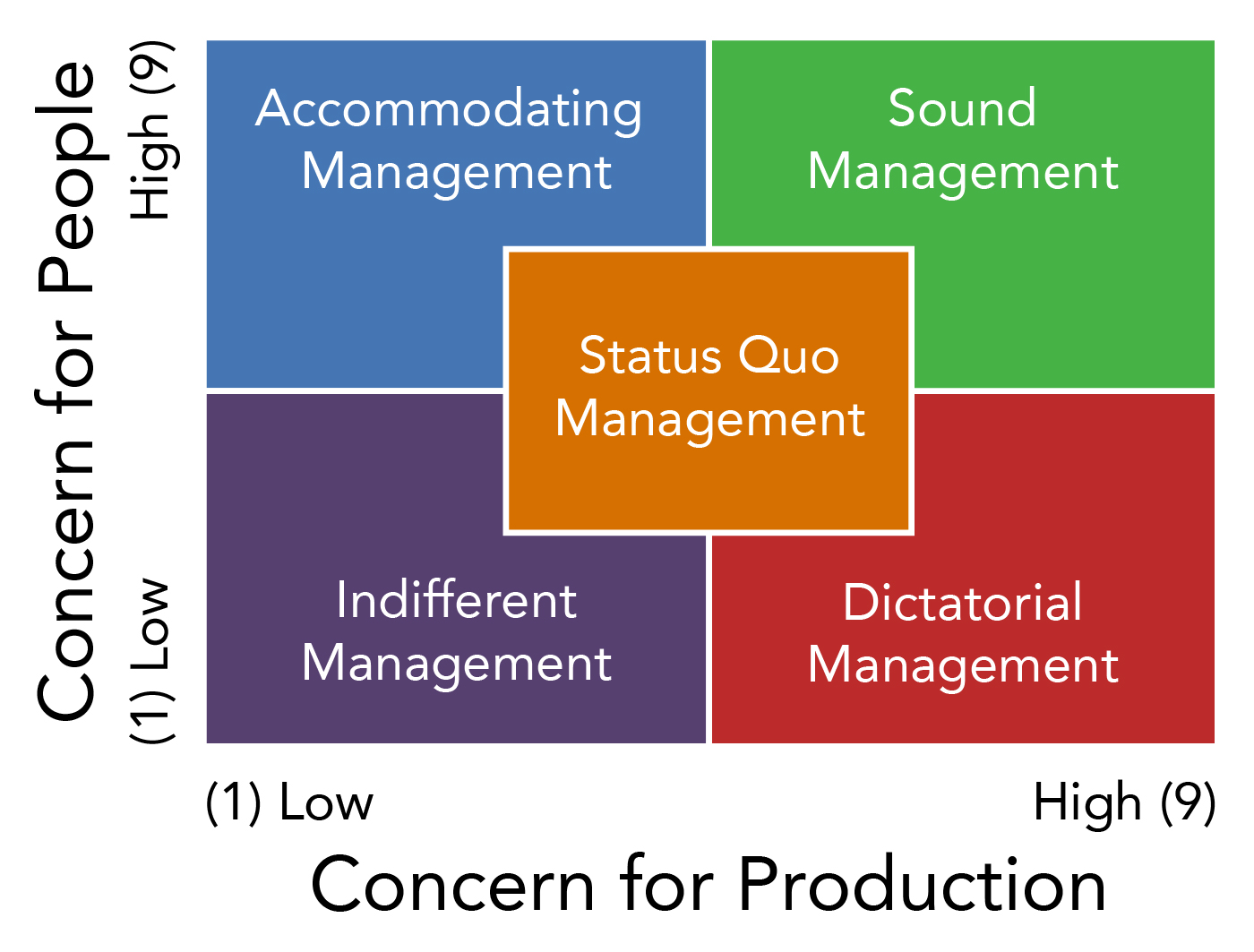
- In the accommodating management style, leaders yield and comply. They pay attention to the comfort of the employees in hopes that they’ll be productive. This style often results in happy employees but is not necessarily productive.
- In the indifferent management style, leaders evade and elude. They don’t give much consideration to people or production, and try to fly under the radar a bit without getting into trouble.
- In the sound management style, leaders contribute and commit. They pay high attention to both people and production and encourage teamwork and commitment. It’s very Theory Y!
- In the dictatorial management style, leaders control and dominate. They pay attention to production but not to people, and use rules and punishment to achieve goals. It’s very Theory X!
- In the status quo management style, leaders balance and compromise. They are middle-of-the-road, and as a result, people needs and production needs aren’t necessarily met.
Managers performed best when they scored in the “sound” area. But the grid offered better framework for conceptualizing leadership style rather than presenting any new information in clarifying leadership behaviors, because there’s very little substantive evidence to support the conclusion that a sound style is most effective in all situations.
The Scandinavian Studies
We’re going to fast forward a few years to the 1990s, when Scandinavian researchers Ekvall and Arvonen began to reassess the idea that there were only two dimensions that captured the essence of leadership behavior.[4] In a changing world, they decided, leaders would exhibit development-oriented behavior. By exhibiting development-oriented behavior, these leaders would value experimentation, seek out new ideas and generate and implement change.
In their review of the Ohio State studies, Ekvall and Arvonen found that the researchers had identified behaviors such as “pushes new ways of doing things” and “encourages employees to do new things,” but those items didn’t explain much about leadership in 1940s, when those behaviors didn’t have as great an impact. Their studies indicate that just concentrating on two different dimensions of behavior may not be adequate to capture leadership in the twenty-first century.
Behavioral theories had modest success in identifying consistent relationships between leadership behavior and group performance. But none of these consider situation as a factor. Would Ralph Nader have been as successful a consumer activist if he’d been in Nicaragua and not the United States? Would Franklin Delano Roosevelt have been as successful leading the nation through the Revolutionary or the Civil Wars? None of these behavioral theories could clarify these situational differences. So, as we continued to grow in our theories of leadership, we started to look at contingency theories—theories that considered the leader and the situation.
Contingency Approach
We know that traits and behaviors both have an impact on a leader’s success, but what about situation? This is the contingency approach. Circumstances might lead to peers and followers shunning a particular leader, and then seeing him or her in a different way later on. Since the 1960s, the guiding light for research has been the assumption that what makes a leader great depends on the situation.
The failure of researchers to arrive at any consistent results around leadership in the mid-twentieth center led to the study of situational influence. As they started to realize that a certain style and set of skills was appropriate for one situation and failed in another, they sought to determine which conditions matched which styles and skills. This led to several theories on isolating key situational variables, and we’ll look at a few of those now.
Fiedler Model
Fred Fiedler developed the first comprehensive contingency model for leadership and proposed that effective group performance depended on a solid match between the leader’s style and the degree to which the situation gives control to the leader.[5]
Fiedler started his study by determining whether a leader was more task oriented or relationship oriented in his or her behavioral traits. He determined to measure the leader’s propensity to one trait or another by developing the least preferred coworker questionnaire (LPC). The least preferred coworker asked leaders to react to sixteen sets of contrasting adjectives that would describe their least preferred coworker. LPCs respondents that described their least preferred coworker in relatively positive terms, it stood to reason that the leader employed a relationship based approach. Those that described their least favorite coworker unfavorably were deemed to be more task oriented.
It’s worth noting that about sixteen percent of those taking the evaluation scored right in the middle and fall outside the predictions of this theory. So the rest of our discussion concentrates on that 84% of respondents that took one side or the other.
At this point, Fiedler sought to define situations by which to compare these results. He did, in fact, identify three contingency dimensions that he was convinced defined the key situation factors that determine leadership effectiveness. Those situations were
- Leader-member relations: the degree to which members have confidence and trust in their leader (good or poor).
- Task structure: the degree to which job assignments are proceduralized (high or low).
- Position power: the degree of influence a leader has over power variables, such as hiring, firing, discipline, promotions and salary increases (strong or weak).
Fiedler then started comparing task-oriented and relationship-oriented leaders and their performances, based on the twenty-four possible combinations of the situations above, and this was the result:
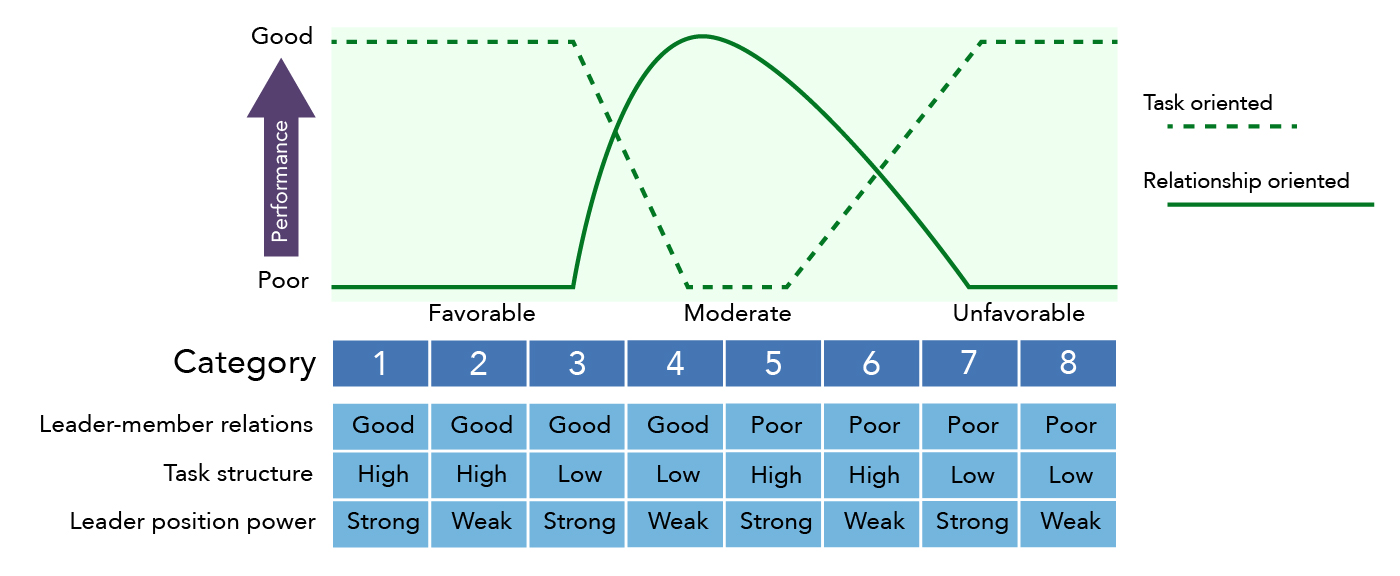 Figure 1. Fiedler Model
Figure 1. Fiedler ModelFiedler concluded that task oriented leaders tended to perform better when situations were very favorable or very unfavorable to them. Relationship oriented leaders perform better when situations are moderately favorable. Fiedler then modified his conclusions to state that task oriented leaders performed better in situations of high or low control, while relationship oriented leaders performed better in situations of moderate control.
While there are problems with the LPC evaluation and studies show that respondents’ scores are not stable, there is considerable evidence to support Fiedler’s conclusions. Still, it’s often difficult in practice to determine the quality of leader-member relations, the structure of task and how much position power the leader possesses.
Cognitive Resource Theory
More recently, Fiedler and an associate, Joe Garcia, reconceptualized Fiedler’s original theory, this time focusing on the role of stress as a form of situational unfavorableness and how a leader’s intelligence and experience influence his or her reaction to it.[6]
Essentially, Fiedler and Garcia propose that it’s difficult for leaders to think logically or analytically when they’re under stress, and how their intelligence and experience impacts their effectiveness in low- and high-stress situations. In other words, bright individuals perform worse in stressful situations, and experienced people perform worse in low-stress situations. This theory is garnering solid research support.
Hersey and Blanchard’s Situational Theory
The term “situational leadership” is most commonly derived from and connected with Paul Hersey and Ken Blanchard’s Situational Leadership Theory. This approach to leadership suggests the need to match two key elements appropriately: the leader’s leadership style and the followers’ maturity or preparedness levels.
The theory identifies four main leadership approaches:
- Telling: Directive and authoritative approach. The leader makes decisions and tells employees what to do.
- Selling: The leader is still the decision maker, but he communicates and works to persuade the employees rather than simply directing them.
- Participating: The leader works with the team members to make decisions together. He supports and encourages them and is more democratic.
- Delegating: The leader assigns decision-making responsibility to team members but oversees their work.
In addition to these four approaches to leadership, there are also four levels of follower maturity:
- Level M1: Followers have low competence and low commitment.
- Level M2: Followers have low competence, but high commitment.
- Level M3: Followers have high competence, but low commitment and confidence.
- Level M4: Followers have high competence and high commitment and confidence.
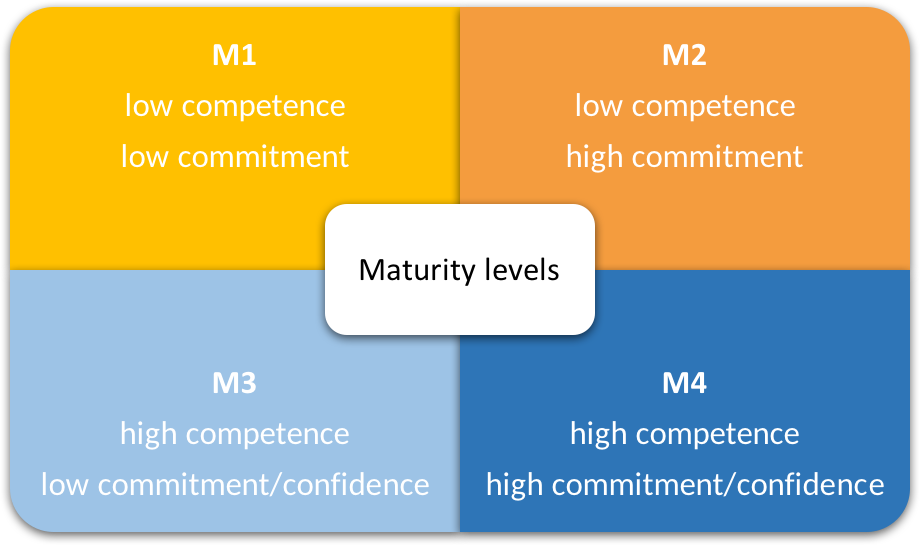 In Hersey and Blanchard’s approach, the key to successful leadership is matching the proper leadership style to the corresponding maturity level of the employees. As a general rule, each of the four leadership styles is appropriate for the corresponding employee maturity level:
In Hersey and Blanchard’s approach, the key to successful leadership is matching the proper leadership style to the corresponding maturity level of the employees. As a general rule, each of the four leadership styles is appropriate for the corresponding employee maturity level:
- Telling style works best for leading employees at the M1 level (low competence, low commitment).
- Selling style works best for leading employees at the M2 level (low competence, high commitment).
- Participating style works best for leading employees at the M3 level (high competence, low commitment/confidence).
- Delegating style works best for leading employees at the M4 level (high competence, high commitment/confidence).
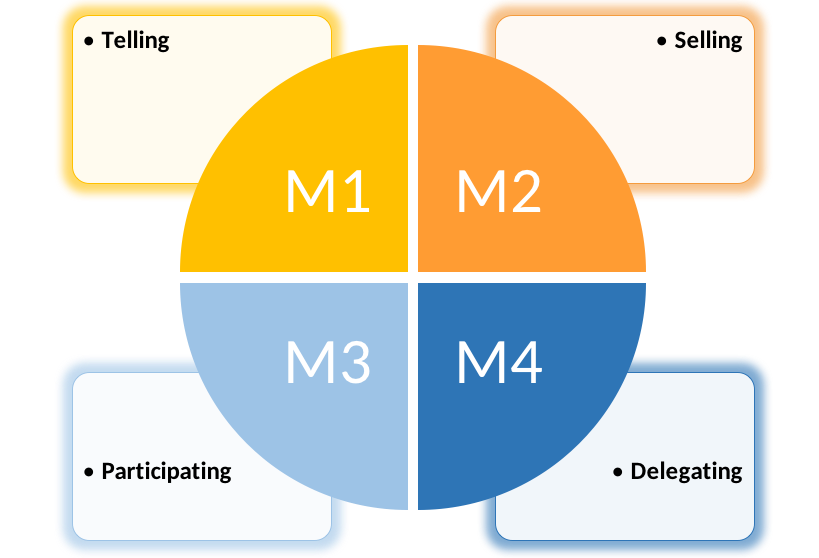 Maturity levels and leadership styles
Maturity levels and leadership stylesIdentifying the employee maturity level becomes a very important part of the process, and the leader must have the willingness and ability to use any of the four leadership styles as needed.
Leader-Member Exchange Theory
The leader-member exchange theory considers leaders relationships with people, and proposed that, because of time constraints, leaders establish relationships with a small group of their followers.[7] These individuals make up an “in-group” and are more likely to receive attention from the leader. Other followers fall into the “out-group.”
How the leader chooses the “in-group” is somewhat unclear, but it’s assumed that the leader chooses the individuals based on their similarities to his or her own characteristics, or because of their higher competence levels.
Research testing the leader-member exchange theory has been generally supportive and provides evidence that leaders do differentiate among followers, that these disparities aren’t random, and that the individuals in the “in-group” will perform better, have lower turnover, etc.
Path-Goal Theory
In the Path-Goal theory, it’s the leader’s job to assist followers in attaining their goals and to provide the necessary direction and/or support to ensure their goals are compatible with the overall objectives of the group or organization.[8] Developed by Robert House, he determined that there were four types of leaders that played into this theory:
- The supportive leader: is friendly and shows concerns for the followers.
- The participative leader: checks with followers for suggestions before making a decision.
- The directive leader: lets followers know what work is to be done, gives guidance on how to accomplish tasks.
- The achievement-oriented leader: sets challenging goals, expects followers to perform at high levels.
The factors are environmental (task structure, formal authority system, work group) and subordinate (locus of control, experience, perceived ability). The environmental factors are beyond followers’ control, and the subordinate factors are, obviously within their control. Environmental factors dictate which of the leadership behaviors above will be most effective, and the subordinate factors dictate how those leadership behaviors are interpreted.
In other words, if a directive leader is paired with followers who already have a high ability and experience, the leader’s skills are likely to be perceived as redundant. The followers don’t need someone to tell them what to do. They’d be more successful with an achievement-oriented leader.
Research supports this theory. It’s logical that a leader will be successful if he or she is “filling in the blanks” where environmental and subordinate factors are concerned, and giving the team what they don’t already have.
Leader-Participation Model
Victor Vroom, the researcher who developed the expectancy framework by which we compared motivational approaches, also has things to say about leadership.[9] He paired with Phillip Yetton to create a leader-participation model, and then with Arthur Jago to create a revised one. The revised model , the more widely accepted of the two, provides a set of rules to determine the form and amount of participative decision making in different situations.
In fact, there are 12 contingency variables, 8 problem types, and 5 leadership styles to be considered in the process, and that’s part of what makes the model difficult for managers to use. Beyond the complexity of the model, this model doesn’t take stress, intelligence and experience into consideration as important variables.
Note on Attribution
Chapter 2.1 The History of Leadership Theories was adapted from “The History of Leadership Theories” by Lumen Learning, licensed under CC BY 4.0.
- Stogdill, "R and A. E. Coons, Leader Behavior: Its Description and Measurement, 1951" ↵
- "Kahn, R and D. Katz. \"Leadership Practices in Relation to Productivity and Morale,\" Group Dynamics: Research and Theory, 1960" ↵
- "Blake, R. R. and J. S. Mouton. The Managerial Grid. 1964" ↵
- Ekvall, "G and J. Arvonen, \"Change-Centered Leadership: An Extension of the Two-Dimensional Model,\" Scandinavian Journal of Management, 1991. M. Lindell and G. Rosenqvist, \"Is there a Third Management Style?\" Finnish Journal of Business Economics 3, 1992. M. Lindell and G. Rosenqvist, \"Management Behavior Dimensions and Development Orientation,\" Leadership Quarterly, 1992." ↵
- Fiedler, "F. E. (1967) A Theory of Leadership Effectiveness, New York: McGraw-Hill." ↵
- Fiedler, "F. E. and Garcia, J. E. (1987) New Approaches to Leadership, Cognitive Resources and Organizational Performance, New York: John Wiley and Sons." ↵
- Dienesch, "R.M. and Liden, R.C. (1986) Leader-Member Exchange Model of Leadership: A Critique and Further Development. Academy of Management Review, 11, 618-634." ↵
- House, "Robert J.; Mitchell, T.R. (1974). \"Path-goal theory of leadership\". Journal of Contemporary Business. 3: l–97." ↵
- Vroom, "Victor H.; Yetton, Phillip W. (1973). Leadership and Decision-Making. Pittsburgh: University of Pittsburgh" ↵

